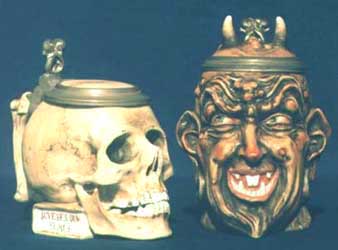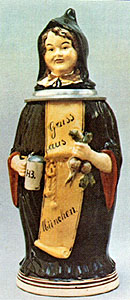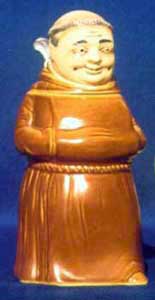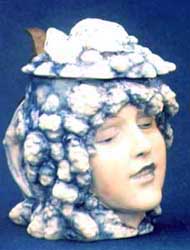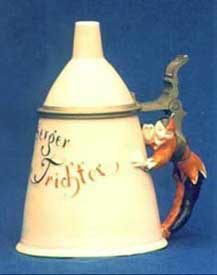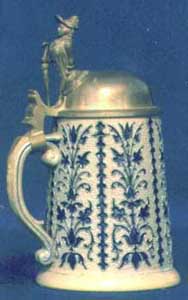Why a Character Stein?
by Jack G. Lowenstein
This article, which appeared as an introductory chapter in The Encyclopedia of Character Steins by Dr. Eugene Manusov (Wallace-Homestead Book Co., Des Moines, IA, 1976) is reproduced with the permission of Dr. Manusov. Minor changes have been made to account for separation of this article from the rest of the book, to divide the article into sub-sections, and in a very few cases, to update the text to reflect the advance of knowledge which has occurred in the twenty-plus years since originally written. The new sub-section headings are obvious, and other changes have been marked with square brackets. In addition, illustrative photographs have been added. — Ed.
Artistic Heritage of Character Steins
Man’s earliest artistic instinct was somehow to copy and thus preserve what he saw in nature. Cave drawings depicting primitive attempts of this type of imagery have been uncovered all over the world. Little wonder then that the ancient clay worker also turned to nature for his models: the world around him — often difficult to comprehend — was reproduced in simple, understandable, and permanent forms, the clay worker’s imagination limited only by the pliability of the clay in his hands. Countless examples of early pottery in the crude form of animals and humans attest to this beginning of the potter’s art.
It wasn’t long before our ancient clay worker tired of modeling little figurines and instead turned to making useful objects. Pots, dishes, bowls and other assorted utilitarian items replaced such natural objects as coconut shells, palm fronds, sea shells, and hollowed-out wood. But he never forgot his first love, and soon he found ways of combining his artistic copying with his more mundane work. The result, of course, was a utilitarian receptacle in the shape of an animal. Figural or character vessels had been invented!
As pottery and ceramics advanced and developed into full-blown forms of art, the concept of figurals also was perfected. Chinese porcelain figural vessels were produced as early as 200 B.C., Greek figural items as early as 1200 B.C., and Minoan items as early as 2000 B.C. In Europe, where the discovery of stoneware in the 13th century heralded a new era, figural vessels were known almost from the very beginning. As soon as the people of the Middle Ages found that the new stoneware items were able to hold liquids better than anything that came before (except expensive glass and metal), they began to artistically decorate the marvelous new mugs and tankards — and once again the figural model was re-born. The Bartmann Krüge (“Bellarmine jugs”) of the early 16th century, the Eulenkrüge (“owl jugs”) of the mid-16th century, and the Medici “porcelain” figural ewers of the late 15th and early 16th centuries are probably the earliest examples of what might be classified as “character steins”; the famous Brixener Eulenpokal (“owl tankard”) of about 1540 may, however, be the first true character stein, since its purpose as a drinking vessel — rather than storage vessel — appears clear.
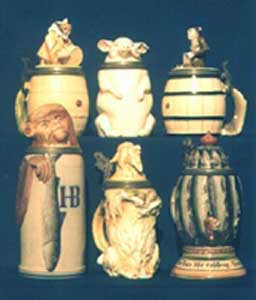 |
But the character stein didn’t really come into it’s own until the 1850s, when a more relaxed way of living, combined with a German artist’s renaissance and an emphasis on beautiful, unique, and sometimes personalized beer-drinking vessels, gave impetus to the design, manufacture, and widespread use of these ingenious steins.
Common Types of Character Steins
Figural steins were shaped like animal or human heads, figurines, or other “characters”. Whimsy naturally played a large part, and allegorical figures, animals with pseudo-human features, and popular or humorous figures were (and still are) great favorites. [The Encyclopedia of Character Steins] is a tribute to the vast imagination of the character stein designer, to the spectrum of characters turned into useful drinking vessels, and to the great humor and satire expressed in these clever figurals.
Cats, Monkeys, Goats, Pigs, Foxes, Owls
Let’s discuss some of the better known “characters”. The beer-drinking and beer-loving Germans even personified the condition of inebriation: To be drunk was to have a Kater (“tomcat”), and a hangover is known by the same name. Similarly, to have a monkey (Affe) on one’s back was to be a drunk. Spring beer is known as Bock (“ram” or “goat”) Bier; to have good luck is to have Schwein (“pig“); as in the United States, to be clever is to be a “fox”; of course, a night person is an “owl”; also a scholar might be termed an “owl”. Thus the tomcat, the monkey, the goat, the pig, the fox, and the owl were early character stein favorites. They were given human features, clothes to wear, and pipes to smoke. The owner of such a stein said, in effect, “Look here — I like my beer and I’m proud of it!”
Radishes
Big, white radishes are the favorite beer snack in the Bavarian mountains. Thus the happy and the sad radish character steins were naturals. One radish was happy because he made the legendary Bavarian beer even more enjoyable, while the other one was sad because he foresaw his own early demise.
Stags, Bears, Boars, Foxes, Rabbits (Hunting Motif)
Hunting is a popular European sport. The Germans took hunting very seriously because game was so plentiful within their borders. And, after the hunt, what more pleasant pastime than to sit in the warm hunting lodge and swap some tall tales over a foaming stein or two? (Countless German paintings of the 19th century depict just such scenes.) It is quite obvious that the true Kenner (“connoisseur”) would want to show off his hobby (hunting, not drinking). The result was character steins in the shape of stags, bears, boars, foxes, rabbits, and other assorted denizens of the forest. To minimize the idea that these animals were the “victims” of the sport, they were instead often depicted as the hunters themselves — they were given human features, “wore” hunting clothes, and carried guns. After all, what could be a slyer dig than a stein in the shape of a rabbit, walking on his hind legs, dressed as a hunter with gun over his shoulder, and carrying a game sack out of which peered a small human being?
Skulls and Devils
The mere thought of drinking out of a skull has intrigued man for centuries. Monks were often accused of this grisly custom in the Middle Ages by the ignorant and the malicious. Little wonder, then, that a skull character stein should appear! Being made of stoneware or pottery, instead of bone, it legitimized the hidden, morbid desires. Indeed, it made fun of them. Thus we find skull steins of all types: osteologically correct skulls; skulls resting on books (variously inscribed seriously or humorously — Gaudeamus Igitur (“So let us be joyful”) seems to be a favorite; skulls with ravens on top; skulls with an ancient candle on top of the cranium; even skulls which, when turned around, revealed a grinning devil. Once the initial revulsion was overcome, the imagination of the stein designer seemed to have no limits.
The devil himself was a fascinating model for the character stein maker; zum Teufel is a favorite German expletive (not always deleted), and someone who drank too much was — according to some — surely on his way to the netherworld and its fiery, horned, and tailed master. Hence what better figural out of which to drink one’s beer? Like the skull, the devil steins come in many configurations, from stern, threatening, and frightening to scowling, enticing, and downright
lovable.
Munich Child, Monks and Nuns
But there are probably no better-known character steins than the Munich Child steins! The Münchner Kindl, as it is known in its home town of Munich, is the beloved symbol of that fair city and Bavaria. Created as the coat-of-arms or archival seal of Munich in 1239, it has evolved from a hooded monk standing in front of Munich’s gate to a charming child, still dressed in hood and cape but now holding a foaming stein of beer and a bunch of radishes instead of the Book of Law. A most impressive history of the metamorphosis of the Munich Child was written by Ernst von Destouches in 1905. The change from monk to child was slow and almost imperceptible; by 1865 the official seal of Munich was represented by a youngish figure with definite religious overtones (red halo, right hand extended in blessing). Yet the new post-war seal has returned to the monk figure, stylized but recognizable.
It was up to the artists, the painters, the sculptors, and the printers to transform the seal-figure into the beer drinkers Munich child. In the second half of the 19th century the fun-figure emerged — always holding that stein — and at once it became the “official” symbol of all Münchner (“citizens of Munich”). The child found its way to posters, to paintings, to newspaper mastheads, to calendars, to all types of decorative articles, and naturally, to beer steins. Literally thousands of different Munich Child representations were immortalized on PUG, painted, relief, and etched stoneware, porcelain, glass and pewter steins! Little wonder then that Munich Child character steins were not far behind. The figure is easy to model and the artistic possibilities are limitless. Famous stoneware and porcelain workers, such as Josef Reinemann and Josef M. Mayer (both of Munich), turned out wondrous arrays of Munich Child character steins. Some were made of stoneware, others of porcelain (sometimes with lovely, almost life-like bisque faces), and still others of pewter. Almost every stein manufacturer (with the notable exception of Villeroy & Boch) tried his hand at a Munich Child character or two, all with unique features of style, from the 1870s to the present, which accounts for the large number of these characters still being found. From the cherubic to the irreverent, from the ultimate in refinement to the common and crude, the Munich Child character stein is instantly recognizable by it’s hood, it’s robe with cross-shaped belt, the radishes, and the ever-present foaming stein.
Character steins portraying nuns and monks are a cross between sly mockery and good-natured humor. No harm was ever intended by these little figurals. Besides, how could anyone ever take a beer drinker seriously?
Famous People
Even famous people were immortalized on character steins: President Otto von Bismarck; Field Marshall Paul von Hindenburg; both Kaisers Wilhelm (I and II); Count Ferdinand von Zeppelin; Uncle Sam. They all found their way into this form of sculpture. Here no mockery was intended. The owner of a character stein depicting a real person was showing his respect, his true liking for the person, whether past or present.
Other Human Figurals
The jump from representing real people to imaginary ones was easy, and therefore [we observe] a large number of “people” figurals. Men and women from all stages of life, from all professions, from mythology and from folk-tales, or just from the imagination of the stein manufacturer, can be found in the form of steins. Here we see finely detailed sculptures or crude imagery. Whether the character stein represents the ever-maligned mother-in-law or the sexy barmaid, the chivalrous gentleman or the rascally imbiber, a servant girl or a mountaineer, an Indian or the Heidelberg dueling student, the humor, the cleverness and the fancy are always apparent to the viewer. Often a line or two of text on the steins relates the figure to some aspect of life, mostly beer drinking. (The German texts are often arduous and tortured to form a rhyme or to fit the space. Therefore they are sometimes difficult to translate or even to understand. The combination of poetic license and local dialects can easily defeat the translator. If nothing else, the literal translation often completely misses the point of humor and hence becomes senseless.)
The variety of character steins certainly seems endless. It is just about impossible to verbally catalogue every item — a[n evening with The Encyclopedia of Character Steins] is necessary to
convince oneself of the magnitude of character stein types.
The Nuremberg Funnel
Only one final character stein deserves detailed comments: der Nürnberger Trichter (“the Nuremberg Funnel”). Although Nuremberg is represented in the world of steins by its famous tower and by the Goose Man, it is the Funnel which is the enigma. The tower, of course, is the Spittlertortum (“Spittler Gate Tower”), one of the six towers surrounding Nuremberg, and the Goose Man is a figure from one of that city’s famous fountains. But the Funnel — just what does it mean? What does it represent? Several variations of the funnel stein are known. One is in the form of the funnel itself (with jester handle), another features the funnel as a man’s hat, while a third shows the funnel as being used (again by a jester) to pour something into a fool’s head. Our guess is that the funnel is used to funnel knowledge! The clue lies in a postcard (discovered by Frank Love) which shows the funnel being utilized to infuse a potion into a young man, while the text states: Der Nürnberger Trichter — Sicher und schnell — Macht er die Köpfe hell!” The translation is: “The Nuremberg funnel: Surely and quickly — it makes heads bright!” This ties in with the figure of the jester (the court fool) and the dumb expression on the figure being “infiltrated”. There may well be other theories, but for the time being this one seems to be the most reasonable.
Thumblifts and Lithophanes
Much could be said about the variety of thumb-lifts and lithophanes found on and in character steins. The thumb-lifts, cast in pewter, often match the motif of the stein (such as the use of the twin towers of Munich’s Cathedral of Our Lady on Munich Child steins, or the above-mentioned Goose Man on Nuremberg Tower steins), or else are one of a myriad of other decorative designs. Lithophanes, those translucent pictorial bases in [porcelain] steins which become visible when the empty stein is held against the light, usually mirror some aspect of the stein itself or the location where the stein was made or sold. Thus, military figurals will feature a lithophane depicting a soldier, and officer, or another military personality. Munich Child steins most often have lithophanes showing the famous Bavaria statue on the Theresien Meadow in Munich. Nuremberg steins show the Nuremberg castle or one of the well-known, ornate Nuremberg fountains. Heidelberg steins will usually have a lithophane of the Heidelberg castle, high above the Rhine. On the other hand, many of the lithophanes in character steins are of the “general” variety: a girl reading a letter from a boyfriend; a group of men playing cards; a family scene in front of a fireplace; a shepherd and shepherdess exchanging a kiss; and other similarly bucolic scenes. (Interestingly, beer steins were always considered “family-type” items — hence risqué or indecent lithophanes are exceedingly rare [in old steins]. Even the socially acceptable artistic female nude is only very rarely encountered. Hence we might say that beer steins, especially character steins, could be rated “PG”.)
Since one comes across the same lithophane views again and again, often in rather dissimilar steins by different manufacturers, one might assume that lithophanes were manufactured centrally and then purchased by stein manufacturers to be “inserted” into porcelain steins. Alternatively, perhaps the lithophane molds were sold to the stein makers, to be used as the matrix from which to form the final translucent base panel.
Conclusion
Character steins came into being and are collectible even today because they are artistic, they depict the humorous side of life, sometimes they have a tale to tell, they express a whimsy, a fantasy — yes, a Gemutlichkeit which we find enjoyable and which we attempt to duplicate vicariously by collecting them. In addition, they make great conversation pieces when stacked on a shelf, they spur research into an almost forgotten past, they fulfill our urge to collect, and last, but not least, they make beer taste better and even more fun to drink.
__________
New material ©1998 Beer Stein Library — All rights reserved.





